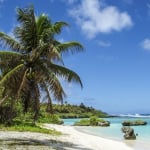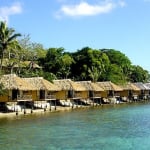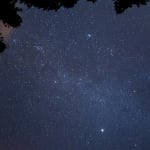Name: Nakano-ya Yuzawa Main Store
Address: 2-1-5 Yuzawa, Yuzawa-machi, Minamiuonuma-gun, Niigata, Japan
Official/Related Website: https://www.umaisoba.com/

Explore Japan’s Three Great Gorges! Kiyotsu Gorge – A Must-Visit Scenic Spot in Niigata
Kiyotsu Gorge (清津峡) is one of Japan’s most breathtaking natural landscapes, located in Tokamachi City, Niigata Prefecture. It was designated as a national park in 1949 and is recognized as one of Japan’s Three Great Gorges alongside Kurobe Gorge and Osugi Valley. The steep rock walls rising on both sides of the Kiyotsu River create a striking V-shaped gorge, where the contrast between the emerald-green waters and the rugged cliffs offers a truly spectacular view. Kiyotsu Gorge has gained increasing popularity as a tourist destination due to its artistic natural scenery. In this guide, we will explore the fascinating charm of Kiyotsu Gorge.
table of contents
[x] close
Explore Japan’s Three Great Gorges! Kiyotsu Gorge – A Must-Visit Scenic Spot in Niigata
1. What is Kiyotsu Gorge?
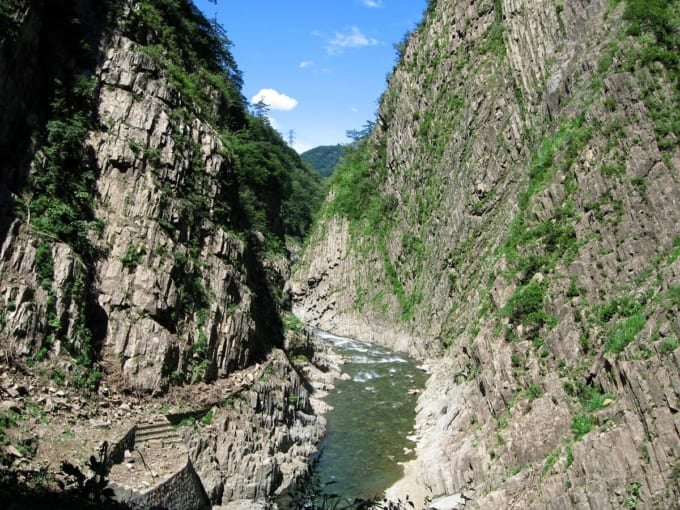
Kiyotsu Gorge's history dates back 16 million years. Volcanic activity beneath the sea formed layers of green tuff, and around 5 million years ago, magma intruded into these layers, solidifying into columnar joints. As the land rose over time, mountains and the Kiyotsu River were formed, with the river gradually carving out the gorge.
Kiyotsu Gorge is a stunning destination where visitors can experience the passage of time through its breathtaking natural formations. It is also highly regarded for its seasonal beauty.
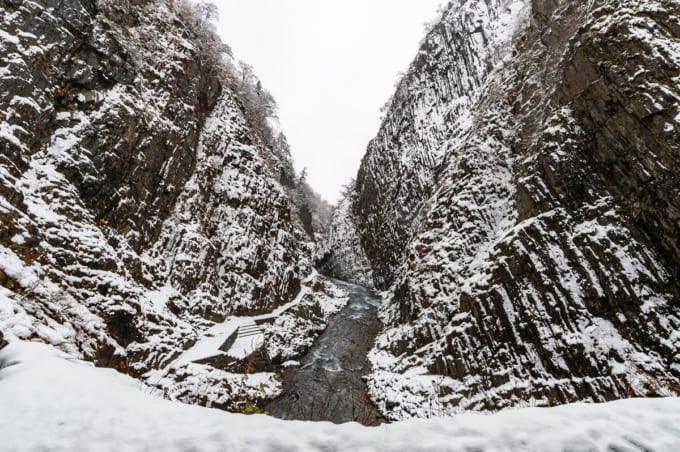
In winter, the gorge transforms into a monochrome world blanketed in snow. Spring brings fresh greenery and the vibrant energy of new life. During summer, visitors can immerse themselves in the refreshing grandeur of nature, while autumn adorns the mountains with spectacular foliage.
2. Kiyotsu Gorge Tunnel
The Kiyotsu Gorge Tunnel is a must-visit attraction where visitors can fully experience the natural beauty of Kiyotsu Gorge. In 2018, it was transformed into an art installation called "Tunnel of Light" by Ma Yansong and MAD Architects as part of the 7th Echigo-Tsumari Art Triennale. Today, it is a highly popular Instagram-worthy spot that attracts photography enthusiasts and travelers alike.
◆ Kiyotsu Gorge Tunnel Entrance Fee
• Adults (high school students and above): ¥1,000
• Children (elementary and junior high school students): ¥400
• Preschoolers: Free
◆ Kiyotsu Gorge Tunnel Reception Hours
8:30 AM – 4:30 PM (Closes at 5:00 PM)
*Winter Season (December to February): 9:00 AM – 3:30 PM (Closes at 4:00 PM)
◆ Kiyotsu Gorge Entrance Operating Hours
9:00 AM – 4:00 PM
At the entrance of Kiyotsu Gorge, visitors can find a souvenir shop and café on the first floor, while the second floor offers a free foot bath, perfect for relaxing after exploring the tunnel. Clean and well-maintained restroom facilities are also available for convenience.
* The foot bath is available only from April to November.
3. Access Information
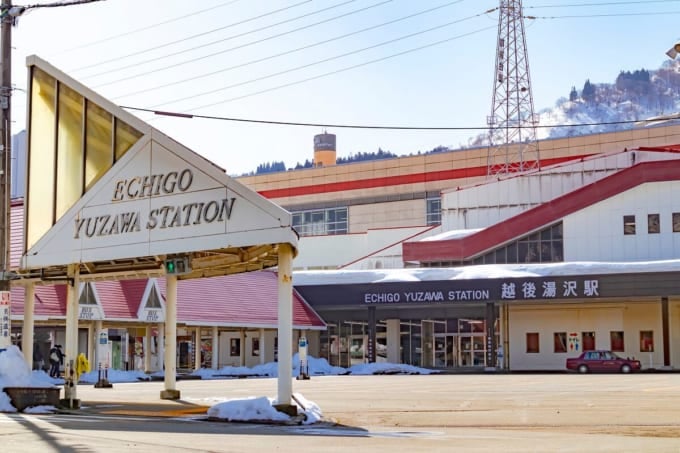
Kiyotsu Gorge can be accessed by both car and public transportation.
◆ By Car
【From Tokyo】
Drive from Nerima IC in Tokyo via the Kanetsu Expressway for approximately 2 hours and 35 minutes until you reach the Shiozawa-Ishiuchi IC. From there, take Route 353 and drive for about 25 minutes to reach the entrance of Kiyotsu Gorge.
【From Niigata】
From Niigata City, take the Hokuriku Expressway and Kanetsu Expressway from Niigata-Nishi IC. Drive for approximately 1 hour and 30 minutes to reach Shiozawa-Ishiuchi IC, then follow Route 353 to the entrance of Kiyotsu Gorge.
◆ By Public Transportation
Travelers from Tokyo Station and Niigata Station can take the JR Joetsu Shinkansen and get off at JR Echigo-Yuzawa Station. From there, board an express bus bound for Morimiyanohara and get off at the Kiyotsu Gorge Entrance bus stop. After disembarking, walk for approximately 30 minutes to reach the entrance. Bus schedules can be checked on the official website of Minami Echigo Kanko Bus Company.
4. Recommended Souvenirs
The town of Tokamachi in Niigata Prefecture, home to the breathtaking Kiyotsu Gorge, is also known for its rich selection of souvenirs that reflect the region’s unique culture and specialties.
◆ Uonuma Koshihikari Rice
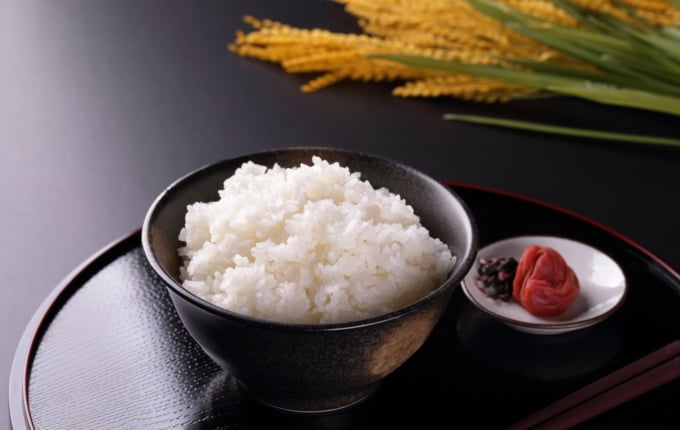
Uonuma Koshihikari is one of the most premium rice varieties in Japan, renowned for its exceptional quality. Tokamachi, where Kiyotsu Gorge is located, is one of its production areas. This high-grade rice is a popular souvenir, widely available at local shops and souvenir stores.
◆ Kagura Nanban (Spicy Green Pepper)
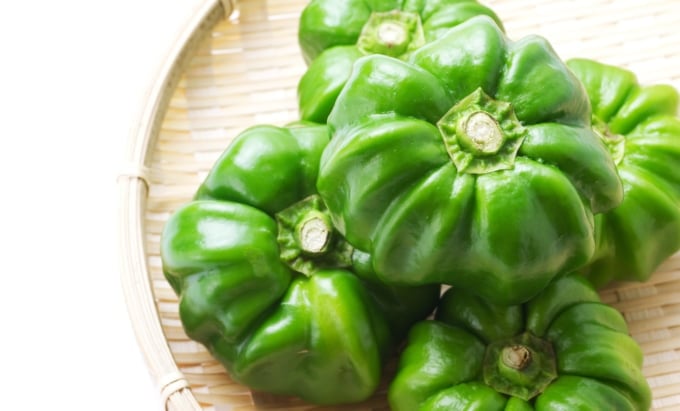
Tokamachi preserves the traditional food culture of Japan’s snow country. Among its unique specialties is Kagura Nanban, a spicy green pepper with a distinctive kick, commonly used as a condiment to enhance the flavor of various dishes.
5. Dining Options Near Kiyotsu Gorge
There are several restaurants near Kiyotsu Gorge where you can enjoy delicious local cuisine.
◆ Nakano-ya Yuzawa Main Store
Nakano-ya Yuzawa Main Store is a well-known restaurant famous for its hegi soba and maitake tempura. This spot is highly popular, often attracting long lines on weekends. You can choose between cold soba and udon, depending on your preference. The soba noodles are made from stone-milled buckwheat flour, offering an authentic taste of traditional Japanese soba.
◆ Restaurant & Café Keikoku
At Restaurant & Café Keikoku, you can enjoy your meal while listening to the soothing sounds of the Kiyotsu River. One of its signature dishes is Keiryu Soba, a specialty of the Kiyotsu Gorge area that you won’t find anywhere else. Don’t miss the chance to savor this unique local delicacy.
Name: Restaurant & Café Keikoku
Address: 2137-2 Koideki, Tokamachi City, Niigata, Japan
Official/Related Website: https://www.tokamachishikankou.jp/spot/keikoku/
6. Relax in the Hot Springs! Matsunoyama Onsen
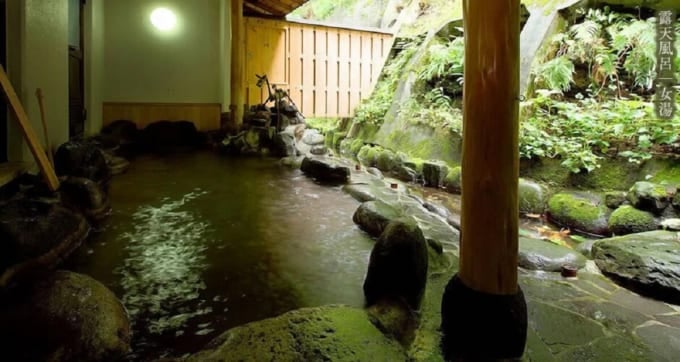
Located in Tokamachi City, Matsunoyama Onsen is recognized as one of Japan’s Three Great Medicinal Hot Springs. Aside from Matsunoyama Onsen, several other hot springs are scattered throughout the city, each offering unique mineral compositions. After exploring Kiyotsu Gorge, why not indulge in a hot spring tour and experience the different healing properties of these onsen?
◆ Japan’s Three Great Medicinal Hot Springs – Matsunoyama Onsen Takanoyu
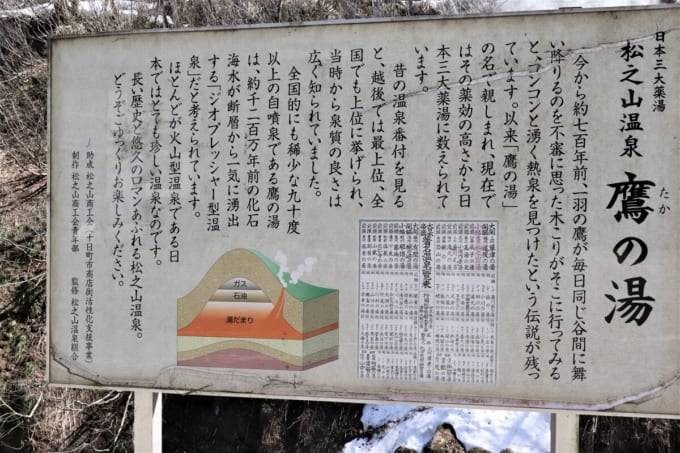
Matsunoyama Onsen Takanoyu is a popular public bathhouse situated in the heart of Matsunoyama Onsen town. The waters here are rich in sodium and calcium chloride, making them particularly effective in retaining warmth, which is perfect for the cold winter months.
Opening Hours: 10:00 AM – 8:30 PM (Closes at 9:00 PM)
Admission Fee: 500 JPY (Free for children under school age)
Closed on: 2nd & 4th Thursday of each month
*If a public holiday, closed the following day
Spring Quality & Benefits: Sodium-Calcium Chloride Spring – Helps retain body heat
Name: Japan’s Three Great Medicinal Hot Springs – Matsunoyama Onsen Takanoyu
Address: 18-1 Matsunoyama Yumoto, Tokamachi City, Niigata Prefecture
Opening Hours: April – November 10:00 AM – 8:30 PM (Closes at 9:00 PM)
Closed on: 2nd & 4th Thursday (Closed the next day if it falls on a public holiday)
Admission Fee: 500 JPY (Free for children under school age)
Official Website:http://www.matunoyama.net/02_onsen.html
◆ Senju Onsen "Sennen no Yu"
Senju Onsen "Sennen no Yu" is a 100% natural hot spring with free-flowing mineral-rich thermal waters that are neither heated nor circulated. Visitors can enjoy two types of baths: Hinoki (Cypress) Bath and Tamaishi (Stone) Bath, which are alternated weekly between men and women. Additionally, an outdoor foot bath is available for free, allowing guests to relax effortlessly.
Name: Senju Onsen "Sennen no Yu"
Address: 121-7 Mizuguchi-sawa, Tokamachi City, Niigata Prefecture
Opening Hours: 10:00 AM – 9:00 PM (Last Entry: 8:30 PM)
Closed on: Open all year round
Admission Fee: Adults (Junior High & Above): 800 JPY / Children (Elementary School): 400 JPY / Free for children under school age
Night Discount (After 6 PM): Adults 700 JPY
Official Website:https://machidukuri-kawanishi.com/sennennoyu/
◎ Summary: Best Time to Visit – Autumn Foliage Season
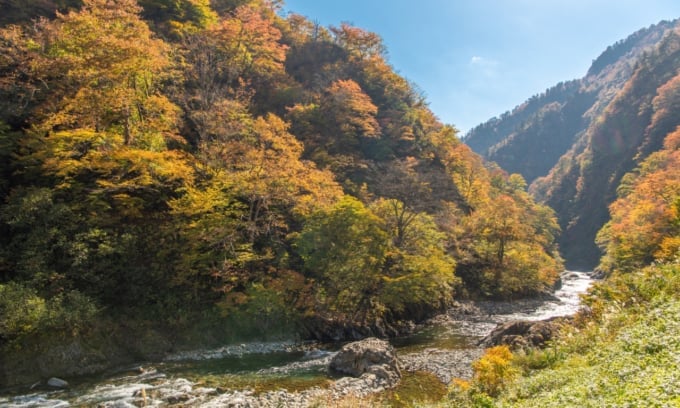
Kiyotsu Gorge is a breathtaking destination that can be enjoyed in any season, but its most popular time is during the autumn foliage season. Every year, the peak for vibrant autumn colors falls between late October and early November. The renovated Panorama Station offers a spectacular view of the gorge, making it an unmissable sight in the fall. If you’re planning a trip, autumn is the perfect time to experience its stunning beauty.
Name: Kiyotsu Gorge
Address: (Kiyotsu Gorge Tunnel) 2126 Koide Kutsugai, Tokamachi City, Niigata, Japan
Official/Related Website: https://nakasato-kiyotsu.com/
*Information as of January 2023.
RELATED ARTICLES
REGIONS
CATEGORIES
FEATURED ON Niigata
-
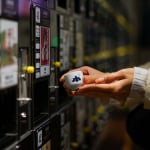
[Niigata] What is Ponshukan? Plus, 10 Recommended Sake Selections from a Certified Kikisake-shi
-

Niigata’s Popular Gourmet Spot! Savor the Bounty of the Sea at Teradomari Fish Market Street!
-
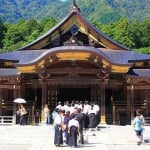
Tour Niigata’s Power Spots in Yahiko Village! 5 Must-Visit Destinations
-
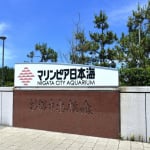
Japan Sea’s Largest Aquarium! Recommended Spots at Marinepia Nihonkai
-

[2023 Edition] Recommended Spots for First-Time Visitors to Niigata Tourism
MOST POPULAR ON Niigata
-
 1
1Doha: Must-see Attractions in the Capital of Qatar
-
 2
2Toronto: 10 Things to do in this Picturesque Canadian City
-
 3
3Amarillo: A City Famous for It’s Amazing Canyons, Great History and Music
-
 4
4South Korea: Dazzling Scenery, Rich Culture and Fascinating History
-
 5
5Kuwait: A Country in Middle East Asia Famous for Hot Sand Dunes and Stunning Cityscape

